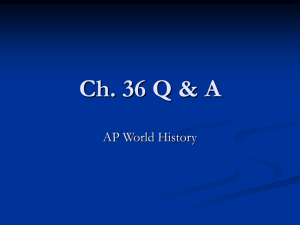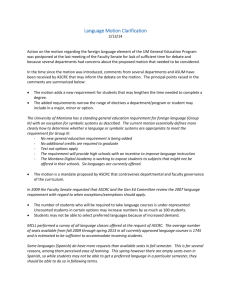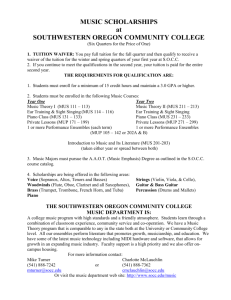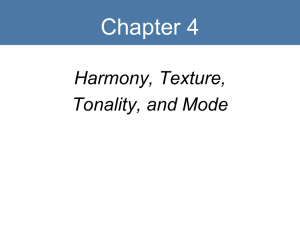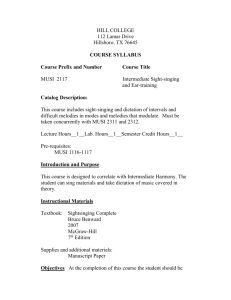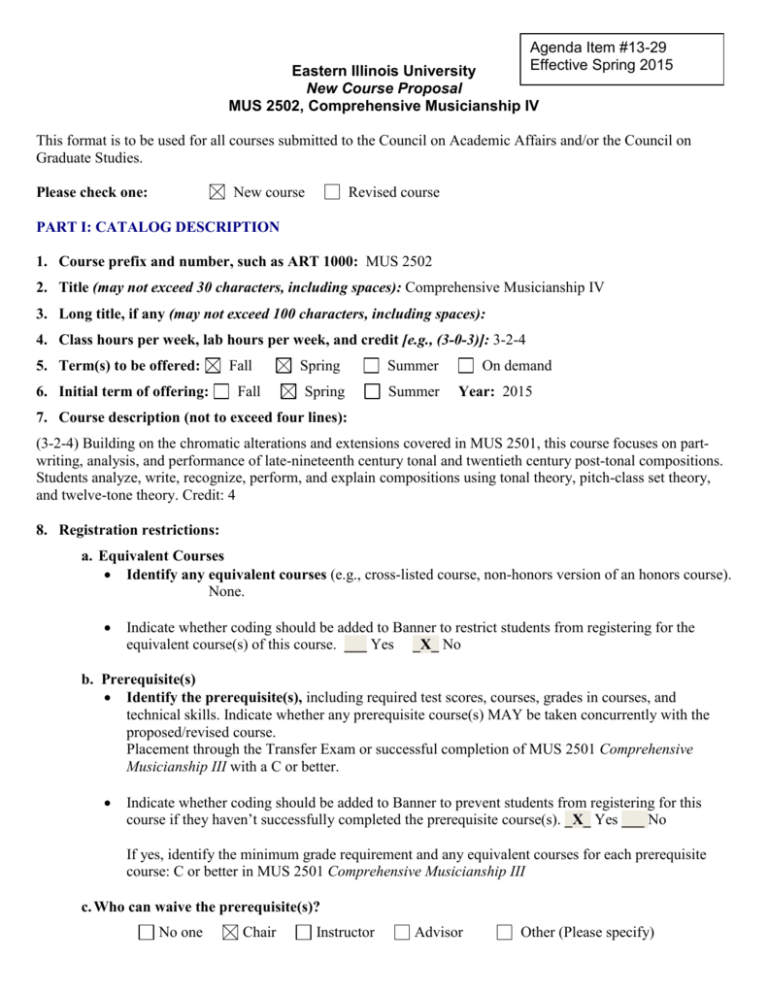
Agenda Item #13-29
Effective Spring 2015
Eastern Illinois University
New Course Proposal
MUS 2502, Comprehensive Musicianship IV
This format is to be used for all courses submitted to the Council on Academic Affairs and/or the Council on
Graduate Studies.
Please check one:
New course
Revised course
PART I: CATALOG DESCRIPTION
1. Course prefix and number, such as ART 1000: MUS 2502
2. Title (may not exceed 30 characters, including spaces): Comprehensive Musicianship IV
3. Long title, if any (may not exceed 100 characters, including spaces):
4. Class hours per week, lab hours per week, and credit [e.g., (3-0-3)]: 3-2-4
5. Term(s) to be offered:
6. Initial term of offering:
Fall
Fall
Spring
Spring
Summer
Summer
On demand
Year: 2015
7. Course description (not to exceed four lines):
(3-2-4) Building on the chromatic alterations and extensions covered in MUS 2501, this course focuses on partwriting, analysis, and performance of late-nineteenth century tonal and twentieth century post-tonal compositions.
Students analyze, write, recognize, perform, and explain compositions using tonal theory, pitch-class set theory,
and twelve-tone theory. Credit: 4
8. Registration restrictions:
a. Equivalent Courses
Identify any equivalent courses (e.g., cross-listed course, non-honors version of an honors course).
None.
Indicate whether coding should be added to Banner to restrict students from registering for the
equivalent course(s) of this course. ___ Yes _X_ No
b. Prerequisite(s)
Identify the prerequisite(s), including required test scores, courses, grades in courses, and
technical skills. Indicate whether any prerequisite course(s) MAY be taken concurrently with the
proposed/revised course.
Placement through the Transfer Exam or successful completion of MUS 2501 Comprehensive
Musicianship III with a C or better.
Indicate whether coding should be added to Banner to prevent students from registering for this
course if they haven’t successfully completed the prerequisite course(s). _X_ Yes ___ No
If yes, identify the minimum grade requirement and any equivalent courses for each prerequisite
course: C or better in MUS 2501 Comprehensive Musicianship III
c. Who can waive the prerequisite(s)?
No one
Chair
Instructor
Advisor
Other (Please specify)
Eastern Illinois University Course Proposal – MUS 2502 Comprehensive Musicianship IV
d.Co-requisites (course(s) which MUST be taken concurrently with this one): None
e. Repeat status:
X Course may not be repeated.
___ Course may be repeated once with credit.
Please also specify the limit (if any) on hours which may be applied to a major or
minor. 4
f. Degree, college, major(s), level, or class to which registration in the course is restricted, if any:
none
g. Degree, college, major(s), level, or class to be excluded from the course, if any: none
9. Special course attributes [cultural diversity, general education (indicate component), honors, remedial,
writing centered or writing intensive]: none
10. Grading methods (check all that apply): X Standard letter ___ CR/NC ___ Audit ___ ABC/NC
(“Standard letter”—i.e., ABCDF--is assumed to be the default grading method unless the course description
indicates otherwise.)
Please check any special grading provision that applies to this course:
___
The grade for this course will not count in a student’s grade point average.
___
The credit for this course will not count in hours towards graduation.
If the student already has credit for or is registered in an equivalent or mutually exclusive course, check
any that apply:
___
The grade for this course will be removed from the student’s grade point average if he/she already
has credit for or is registered in ___________ (insert course prefix and number).
___
Credit hours for this course will be removed from a student’s hours towards graduation if he/she
already has credit for or is registered in ___________ (insert course prefix and number).
11. Instructional delivery method: (Check all that apply.)
___ lecture ___ lab _X_ lecture/lab combined
___ independent
study/research
___ internship
___ performance ___ practicum or clinical
abroad
___ Internet
___ hybrid
___ other (Please specify)
PART II: ASSURANCE OF STUDENT LEARNING
1. List the student learning objectives of this course:
Upon completion of this course, students will be able to:
2
___ study
Eastern Illinois University Course Proposal – MUS 2502 Comprehensive Musicianship IV
(a) analyze composition from the late-nineteenth century repertoire using tonal theory and posttonal compositions using pitch-class set theory and twelve-tone theory;
(b) write harmonic and melodic realizations of tonal and post-tonal phrases;
(c) recognize harmonic and melodic tonal and post-tonal phrase models and their realizations
within the repertoire;
(d) perform tonal melodies using movable-Do Solfège, post-tonal melodies using fixed number and
tonal harmonic progressions on the piano;
(e) perform and conduct rhythms (regular and irregular meters with complex subdivisions,
syncopations, triplets and duplets, hemiola, and metric modulations);
(f) explain how late-nineteenth century tonal and twentieth century post-tonal compositions work,
working with concepts such as equal divisions of the octave, synthetic collections, pitch-class
set theory, and twelve-tone theory.
a. If this is a general education course, indicate which objectives are designed to help students
achieve one or more of the following goals of general education and university-wide assessment:
EIU graduates will write and speak effectively.
EIU graduates will think critically.
EIU graduates will function as responsible citizens.
b. If this is a graduate-level course, indicate which objectives are designed to help students achieve
established goals for learning at the graduate level:
Depth of content knowledge
Effective critical thinking and problem solving
Effective oral and written communication
Advanced scholarship through research or creative activity
2. Identify the assignments/activities the instructor will use to determine how well students attained the
learning objectives:
Written
Assignments
Listening
Assignments
Objective a
X
X
Objective b
X
Objective c
Objective d
Objective e
Objective f
X
X
Fundamental
Performance
Skills Quizzes of Harmonic
Progressions
X
X
X
X
Composition
Project
Exams
X
X
X
X
X
X
X
X
X
X
3. Explain how the instructor will determine students’ grades for the course:
Written Assignments
Listening Assignments
Fundamental Skills Quizzes
Performance of Harmonic Progressions on the Keyboard
Composition Project
Exams (Written Theory 20%, Dictation and Singing 20%)
3
15 %
15 %
15 %
5%
10 %
40 %
X
X
X
X
Eastern Illinois University Course Proposal – MUS 2502 Comprehensive Musicianship IV
4. For technology-delivered and other nontraditional-delivered courses/sections, address the following:
a. Describe how the format/technology will be used to support and assess students’ achievement
of the specified learning objectives:
b. Describe how the integrity of student work will be assured:
c. Describe provisions for and requirements of instructor-student and student-student
interaction, including the kinds of technologies that will be used to support the interaction
(e.g., e-mail, web-based discussions, computer conferences, etc.):
N/A
5. For courses numbered 4750-4999, specify additional or more stringent requirements for students
enrolling for graduate credit. These include:
a. course objectives;
b. projects that require application and analysis of the course content; and
c. separate methods of evaluation for undergraduate and graduate students.
N/A
6. If applicable, indicate whether this course is writing-active, writing-intensive, or writing-centered,
and describe how the course satisfies the criteria for the type of writing course identified. (See
Appendix *.)
N/A
PART III: OUTLINE OF THE COURSE
Provide a week-by-week outline of the course’s content. Specify units of time (e.g., for a 3-0-3 course, 45
fifty-minute class periods over 15 weeks) for each major topic in the outline. Provide clear and sufficient
details about content and procedures so that possible questions of overlap with other courses can be
addressed. For technology-delivered or other nontraditional-delivered courses/sections, explain how the
course content “units” are sufficiently equivalent to the traditional on-campus semester hour units of
time described above.
This course will meet for 75 fifty-minute class periods over 15 weeks.
Sample Course Outline
Weeks 1–5: Late Nineteenth Century Harmony – Equal Division of the Octave
Week 1
Tonal Ambiguity: Semitonal Voice Leading, Diminished Seventh Chord and Enharmonic Modulation.
20th-Century Material: (3) Post-Tonal Melodies 2
Week 2
The Augmented Triad, Altered Dominant Seventh Chords, The Common-Tone Diminished Seventh Chord,
Common-Tone Augmented Sixth Chords.
20th-Century Material: (3) Post-Tonal Melodies 2
Week 3
Chromatic Sequences: Distinctions Between Diatonic and Chromatic Sequences, Chromatic Sequence Types,
Other Chromatic Step-Descent Basses, Writing Chromatic Sequences, and Chromatic Contrary Motion.
20th-Century Material: (3) Post-Tonal Melodies 3
Week 4
4
Eastern Illinois University Course Proposal – MUS 2502 Comprehensive Musicianship IV
Sequential and Nonsequential Progressions, and Wagner, Tristan and Isolde.
20th-Century Material: (3) Post-Tonal Melodies 4
Week 5
Scriabin, Prelude op. 39 no. 2.
20th-Century Material: (3) Post-Tonal Melodies 4
Exams: Written Theory Exam 1 (Class), Keyboard Progressions (Individual), Dictation Exam 1 (Class),
Singing Exam 1 (Individual).
Weeks 6–10: Pitch-Class Set Theory
Week 6
20th-Century Material (1) Pitch-Class-Set Theory: Basic Concepts and Definitions: Octave Equivalence, Pitch
Class, Enharmonic Equivalence, Integer Notation, Mod 12, Intervals, Pitch Intervals, Ordered Pitch-Class
Intervals, Unordered Pitch-Class Intervals, Interval Class, Interval Class Content, Interval-Class Vector,
Analysis: Schoenberg, “Nacht,” from Pierrot Lunnaire, Op. 21.
20th-Century Material: (3) Post-Tonal Melodies 5 and (4) Post-Tonal Sonorities 1
Week 7
20th-Century Material (1) Pitch-Class-Set Theory: Pitch-Class Sets: Pitch Class Sets, Normal Form,
Transposition, Inversion, Set Class, Prime Form, Segmentation and Analysis, Analysis: Schoenberg, “Nacht,”
from Pierrot Lunnaire, Op. 21.
20th-Century Material: (3) Post-Tonal Melodies 6 and (4) Post-Tonal Sonorities 2
Week 8
20th-Century Material (1) Pitch-Class-Set Theory: Additional Relationships: Common Tones under
Transposition and Inversion, Transpositional and Inversional Symmetry, Complementary Sets, Subset and
Superset Relationships, Analysis: Webern, "Five Movements for String Quartet," Op. 5, IV.
20th-Century Material: (3) Post-Tonal Melodies 7 and (4) Post-Tonal Sonorities 3
Week 9
20th-Century Material (1) Pitch-Class-Set Theory: Additional Relationships: Common Tones under
Transposition and Inversion, Transpositional and Inversional Symmetry, Complementary Sets, Subset and
Superset Relationships, Analysis: Webern, "Five Movements for String Quartet," Op. 5, IV.
20th-Century Material: (3) Post-Tonal Melodies 8 and (4) Post-Tonal Sonorities 4
Week 10
20th-Century Material (1) Pitch-Class-Set Theory: Analysis: Berg, "Schläfen trägt man mich," from Four
Songs, Op. 2 or Schoenberg "Angst und Hoffen," No. 7 from Book of the Hanging Gardens, Op. 15.
20th-Century Material: (3) Post-Tonal Melodies 8 and (4) Post-Tonal Sonorities 4
Exams: Written Theory Exam 2 (Class), (Individual), Dictation Exam 2 (Class), Singing Exam 2 (Individual).
Weeks 11–15: Twelve-Tone and Other Serial Techniques
Week 11
20th-Century Material (2) Twelve-Tone Theory: Twelve-Tone Row, Twelve-Tone Matrix, Row Relationships
(Subset Structure), Invariances, Analysis: Dallapiccola, “Die Sonne Kommt,” From Goethe-Lieder For Voice
And Clarinet.
20th-Century Material: (3) Post-Tonal Melodies 9 and (4) Post-Tonal Sonorities 5
5
Eastern Illinois University Course Proposal – MUS 2502 Comprehensive Musicianship IV
Week 12
20th-Century Material (2) Twelve-Tone Theory: Twelve-Tone Row, Twelve-Tone Matrix, Row Relationships
(Subset Structure), Invariances, Analysis Row Relationships (Subset Structure), Invariances, Hexachordal
Combinatoriality, Analysis: Schoenberg, Klavierstück Op. 33a.
20th-Century Material: (3) Post-Tonal Melodies 10 and (4) Post-Tonal Sonorities 6
Week 13
20th-Century Material (2) Twelve-Tone Theory: Row Relationships (Subset Structure), Invariances,
Hexachordal Combinatoriality, Analysis: Webern, “Das dunkle Herz,” Op. 23, No. 1
20th-Century Material: (3) Post-Tonal Melodies 11 and (4) Post-Tonal Sonorities 7
Assignment of Composition Project (Small assignments throughout the second half of the semester prepare
students for this final project.)
Week 14
20th-Century Material (2) Twelve-Tone Theory: Row Relationships (Subset Structure), Invariances,
Hexachordal Combinatoriality, Symmetry Analysis: Webern, Symphonie Op. 21, II. Variations.
20th-Century Material: (3) Post-Tonal Melodies 12 and (4) Post-Tonal Sonorities 8
Week 15
20th-Century Material (2) Twelve-Tone Theory: Selected Analyses: Krenek, Twelve Short Piano Pieces.
20th-Century Material: (3) Post-Tonal Melodies 12 and (4) Post-Tonal Sonorities 8
Performance of Composition Project
Final Examination
Final Written Theory Exam (Class), Final Dictation Exam (Class), and Final Singing Exam (Individual)
PART IV: PURPOSE AND NEED
1. Explain the department’s rationale for developing and proposing the course.
All music majors currently take a four-semester music theory sequence along with a four-semester aural
training sequence. These courses help students develop fluency in reading, writing, and understanding
music. By integrating the music theory and aural training classes into a single comprehensive musicianship
class, we are able to:
(1) emphasize the interrelated nature of musical concepts and their aural perception.
(2) offer a holistic approach to the curriculum which will stimulate students’ interest and involvement.
(3) provide continuity within the curriculum by meeting five days a week with the same teacher (instead of
three times for music theory and twice for aural training often with different teachers).
(4) provide flexibility within the curriculum so it is possible to integrate theoretical understanding, aural
recognition, and performance aspects of musical concepts.
a. If this is a general education course, you also must indicate the segment of the general
education program into which it will be placed, and describe how the course meets the
requirements of that segment. N/A
b. If the course or some sections of the course may be technology delivered, explain
why. N/A
2. Justify the level of the course and any course prerequisites, co-requisites, or registration restrictions.
6
Eastern Illinois University Course Proposal – MUS 2502 Comprehensive Musicianship IV
This course replaces MUS 2542 Music Theory IV and MUS 2544 Aural Training and is appropriately placed at the
2000 level.
3. If the course is similar to an existing course or courses, justify its development and offering.
a. If the contents substantially duplicate those of an existing course, the new proposal should be
discussed with the appropriate chairpersons, deans, or curriculum committees and their
responses noted in the proposal.
This does not duplicate another course.
b. Cite course(s) to be deleted if the new course is approved. If no deletions are planned, note
the exceptional need to be met or the curricular gap to be filled.
MUS 2542 Music Theory IV and MUS 2544 Aural Training
4. Impact on Program(s):
a. For undergraduate programs, specify whether this course will be required for a major or
minor or used as an approved elective.
This course will be required of any music major.
b. For graduate programs, specify whether this course will be a core requirement for all
candidates in a degree or certificate program or an approved elective.
If the proposed course changes a major, minor, or certificate program in or outside of the
department, you must submit a separate proposal requesting that change along with the course
proposal. Provide a copy of the existing program in the current catalog with the requested
changes noted.
see attached
PART V: IMPLEMENTATION
1. Faculty member(s) to whom the course may be assigned: Bernard Borah, Bradley Decker, Stefan
Eckert, and other qualified music faculty members.
If this is a graduate course and the department does not currently offer a graduate program, it must
document that it employs faculty qualified to teach graduate courses.
N/A
2. Additional costs to students:
Include those for supplemental packets, hardware/software, or any other additional instructional,
technical, or technological requirements. (Course fees must be approved by the President’s Council.)
None
3. Text and supplementary materials to be used (Include publication dates):
Textbook Rental:
Steven G. Laitz, The Complete Musician – An Integrated Approach to Tonal Theory, Analysis, and Listening,
Third Edition (New York: Oxford University Press, 2012).
7
Eastern Illinois University Course Proposal – MUS 2502 Comprehensive Musicianship IV
Robert W. Ottman and Nancy Rogers, Music for Sight Singing, Seventh Edition (Upper Saddle River: Pearson
Prentice Hall, 2007).
Supplemental:
Steven G. Laitz, Writing and Analysis Workbook to Accompany The Complete Musician – An Integrated
Approach to Tonal Theory, Analysis, and Listening, Workbook 1, Third Edition (New York: Oxford University
Press, 2012).
Steven G. Laitz, Skills and Musicianship Workbook to Accompany The Complete Musician – An Integrated
Approach to Tonal Theory, Analysis, and Listening, Workbook 2, Third Edition (New York: Oxford University
Press, 2012).
20th-Century Material: (1) Pitch-Class-Set Theory, (2) Twelve-Tone Theory; 20th-Century Theory Material, (3)
Post-Tonal Melodies and (4) Post-Tonal Sonorities; available on the D2L class website.
PART VI: COMMUNITY COLLEGE TRANSFER
If the proposed course is a 1000- or 2000-level course, state either, "A community college course may be
judged equivalent to this course" OR "A community college course will not be judged equivalent to this
course." A community college course will not be judged equivalent to a 3000- or 4000-level course but may
be accepted as a substitute; however, upper-division credit will not be awarded.
A community college course may not be judged as equivalent to this course.
PART VII: APPROVALS
Date approved by the department or school:
Date approved by the college curriculum committee:
Date approved by the Honors Council (if this is an honors course):
Date approved by CAA: February 21, 2013
CGS: N/A
*In writing-active courses, frequent, brief writing activities and assignments are required. Such activities -- some
of which are to be graded – might include five-minute in-class writing assignments, journal keeping, lab reports,
essay examinations, short papers, longer papers, or a variety of other writing-to-learn activities of the instructor's
invention. Writing assignments and activities in writing-active courses are designed primarily to assist students in
mastering course content, secondarily to strengthen students' writing skills. In writing-intensive courses, several
writing assignments and writing activities are required. These assignments and activities, which are to be spread
over the course of the semester, serve the dual purpose of strengthening writing skills and deepening understanding
of course content. At least one writing assignment is to be revised by the student after it has been read and
commented on by the instructor. In writing-intensive courses, students’ writing should constitute no less than 35%
of the final course grade. In writing-centered courses (English 1001G, English 1002G, and their honors
equivalents), students learn the principles and the process of writing in all of its stages, from inception to
completion. The quality of students' writing is the principal determinant of the course grade. The minimum
writing requirement is 20 pages (5,000 words).
8
Eastern Illinois University Course Proposal – MUS 2502 Comprehensive Musicianship IV
Student
Success
Center
Career
Services
Disability
Services
http://www.eiu.edu/~succe
ss/
http://www.eiu.edu/~couns
ctr/
http://www.eiu.edu/~care
ers/
http://www.eiu.edu/~disabl
ty/
581-6696
581-3413
581-2412
581-6583
9


